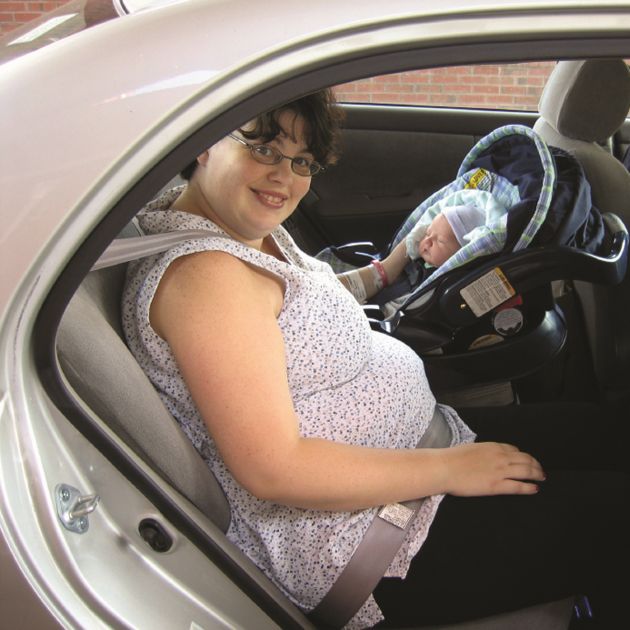Post navigation
Give your new baby a chance to move
- Your baby needs to be placed in a variety of positions to develop strong muscles.
- When your baby is awake, let him have time to lie on his back and his stomach.
- Let him sit in an infant chair.
- Give him something to look at and soon he will be able to lift his chin and then his whole head.
- Let him sit on your lap and against your body, facing out so that he can see what is happening in the room.
Want to Learn More?
For more parenting information, including frequently asked questions and a chance to “Ask the Expert”, go to jitp.info.
 Text4baby will send free text messages to your cell phone with health tips for you and your baby. It’s all free! To sign up, text BABY to 511411 or go to www.text4baby.org.
Text4baby will send free text messages to your cell phone with health tips for you and your baby. It’s all free! To sign up, text BABY to 511411 or go to www.text4baby.org.
Parents need coping skills when a child is born with a disability
In a world where many conditions can be cured, it is hard to accept that a baby may have a condition that can be treated, but not cured. The news is shocking and brings feelings of anger, sadness, anxiety, fear and depression. The anger can be directed at those who bring the bad news, such as doctors and nurses. Parents may also be angry at family and friends for what they see as a lack of support and understanding. Being a new parent is a challenge in itself, but being the parent to a baby with special needs is even more overwhelming!
Parents and friends will experience many emotions. Emotions are healthy reactions to difficult situations. These emotions will not disappear. It is important that parents accept their feelings and use coping skills — such as talking with other parents who have been through this — managing stress, and setting realistic goals.
Talk to someone you trust if you get the baby blues

During the first weeks after your baby is born, you may feel depressed or find yourself crying for no reason. This can happen to mothers and fathers, and may be the let down most of us feel after a long-awaited event has come and gone. There is also the worn-down feeling that follows any sudden change in schedule — like those 2 a.m. feedings. Many parents have these feelings. You will recover your energy and good humor. In the meantime, keep your days as simple as possible.
- Only do what you have to do.
- Don’t expect a great deal of yourself.
- Accept help from other people.
- Plan to nap when your baby does.
- Be flexible.
When you are having a rough time:
- Talk to your partner, a family member, or a good friend about your feelings. It helps to talk with someone close to you.
- Find groups in your community where parents get together to talk and work out solutions to common problems.
- If nothing seems to help and this goes on for several weeks, call your doctor. For some people, medical help is needed.
How much milk is enough for your newborn
Your newborn is getting enough breast milk or formula if he:
- Wets 6 or more diapers every day after 4 days of age.
- Has yellow stools or frequent dark stools after 4 days of age.
- Looks and acts satisfied after feedings.
Gains weight and grows longer. During the first few days of life, babies lose some weight, but after about 10 days, they start gaining weight again and double their birth weight by 5 months of age.
Back to sleep
Back to sleep! Put your baby to sleep on her back to prevent sudden infant death syndrome.
- Do not use soft bedding —such as waterbeds, soft mattresses, pillows, blankets or stuffed animals. Your baby cannot move them if they get on her face and she will not be able to breathe.
- Use a firm mattress, and clothe your baby in a one-piece sleeper outfit to keep her warm while sleeping.
- The Back to Sleep Campaign https://www.nichd.nih.gov/health/topics/sids has information on SIDS.
WARNINGS:
- Do not cover your child with blankets. Put her in a one-piece sleeper outfit to keep her warm.
- Keep the room at a comfortable temperature for an adult.
- Your baby only needs a crib with a mattress with a fitted sheet.
- Never use a pillow.
- Do not place an infant on an adult waterbed. Your child could suffocate!
Use formula to bottle-feed
If you are unable to breastfeed, you will use formula. Formulas are designed to meet the nutritional needs of a growing baby. Discuss with your doctor whether your baby should have an iron-fortified formula or not.
Formula comes in three different forms:
- powdered
- concentrated
- ready-to-feed
Follow instructions carefully. Use a measuring cup to measure the water to be mixed into the powdered or concentrated formulas. Make sure that bottles and nipples are washed and clean before using. If you think your baby is allergic to the formula, talk with your doctor so it can be changed. When you feed your baby, keep the nipple full of formula so she doesn’t swallow air. Hold your baby close with her head up. Don’t leave your baby alone with the bottle propped up, and don’t put her to bed with a bottle because
Newborn babies develop their own regular feeding times
Some babies may like to eat every 3 or 4 hours and some prefer eating more often than that. Newborn babies drink only breast milk or formula. Keeping track of when your baby is hungry may give you an idea of your baby’s feeding pattern. It may help to write down the times that your baby eats for several days to see what her pattern of eating is. Newborns change and grow quickly, so a flexible but regular schedule is best. Remember, your baby may not be hungry every time she is fussy. She may need burping, a diaper change, or may just want to be held
Use a car safety seat to make each ride a safe ride
Being in a car safety seat is the only safe place for an infant when in a car. Always put the infant safety seat in the car’s back seat. NEVER put an infant in a car seat in the front seat. If you have an accident, children are safer in the back seat. Most cars have front passenger side airbags and the force of the airbags can kill infants and small children. Infants need to ride in the back seat — facing the back window of the car — until they reach at least two years of age or until they reach the highest weight or height allowed by their car safety seat’s manufacturer. More information can be found in the article, Car Safety Seats: Information for Families 2012 on the American Academy of Pediatrics website: https://www.healthychildren.org/English/safety-prevention/on-the-go/Pages/Car-Safety-Seats-Information-for-Families.aspx. Read the installation instructions for the car seat. Follow them to properly install the seat in your car. It is recommended that a nationally certified Child Passenger Safety Technician check your child’s safety seat. Call your local highway patrol or fire station for information.
